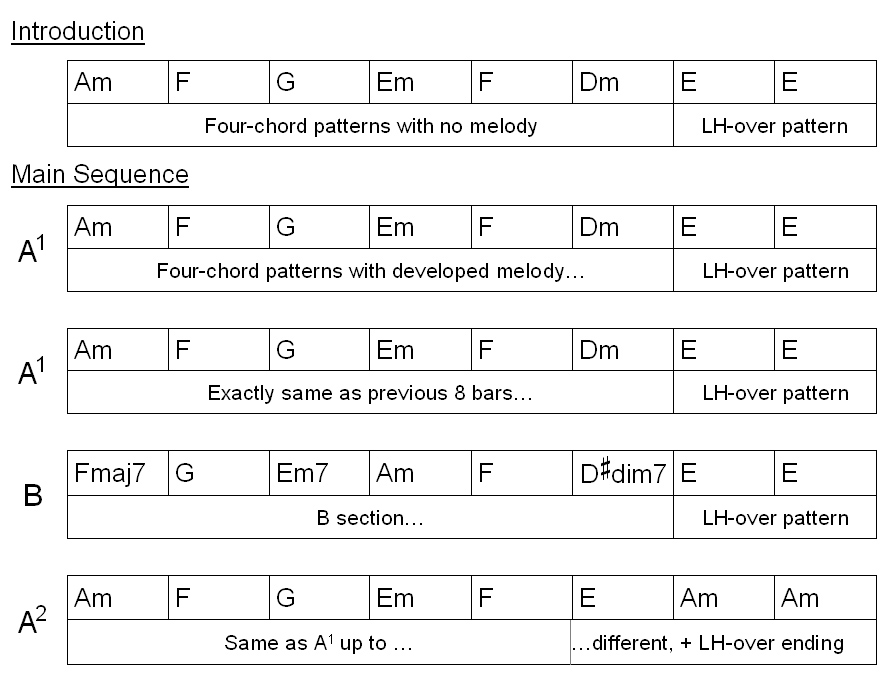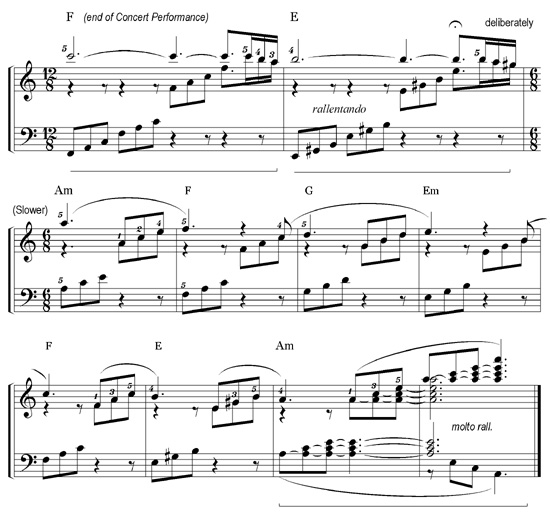Pyramids Variations - Lesson Eight
The Concert Performance
If you have completed lessons One to Seven of this build-up,
you can already play all the music in the Pyramids Concert Performance. All you need to do is add a chords-only Introduction from the Lesson Four Four-chord Version.
The Concert Performance consists of five 8-bar phrases in twelve-eight.
- First you play an Introduction – a four-chord A1 strain without any melody. (You learnt this in Lesson Four.)
- Then you play the 32-bar A1-A1-B-A2 version from Lesson Seven.
Here is a chord chart of the Concert Performance.

Watch it on MisterMusicarta YouTube
If you can remember what you learned in lessons One to Seven in this series, you should be able to play the Pyramids Concert Performance from the chord chart right away.
You will find the music for the Concert Performance on the following pages, but it is important to try to play the music from the chord chart or purely from memory.
In the music, the repeat of the A1 strain is indicated by repeat marks: C B.
If you can read music well, study the music so that you can see how the chord chart represents it, and then use the chord chart on its own.
Watch it on MisterMusicarta YouTube
Make your performance expressive
The music does not have performance markings like tempo and ‘dynamics’ (loudness and softness indications). This is because the Musicarta method is designed to help you play more from your own knowledge and artistic impulse and less from written-out music.
You must put those shadings in yourself. Of course, you will try to ‘bring out the melody’. It is also usual to try to make the B section different in some way, and slow down and fade away at the end.
If you want a really musical performance, spend some time imagining what you yourself would like to hear. What orchestral instruments would you use if you could conduct an orchestra playing the Concert Performance? If the Pyramids music were a film soundtrack, what would be happening on screen? Imagine a concert pianist playing the Pyramids variations in the most outrageously ‘artistic’ manner possible – an aim for that performance.
A Variation-type performance
Make the most of the work you have put into learning Pyramids by playing the full Concert Version at the end of a build-up from the simpler versions.
For example, you could play:
- Pyramids with LH-over Patterns (two-chord, 16-bar A1A2, page 19)
Segue into
- Two-chord AABA performance with developed melody (page 40)
Segue into
- Pyramids Concert Performance (page 60)
To finish, segue into:
- An eight-bar, two-chord A2 with simplest melody to finish (‘reprise’).
In music, segue [seg-wey] means ‘transition without a break into the next section of music or piece’ by making, for example, the last note A of one version the first note A of the next.
Here’s a sketch of the segue into the reprise suggested above.
Watch it on MisterMusicarta YouTube.
Going on from here
This is the end of the build-up to the Concert Performance, but only the start of your creative exploration of just how much beautiful music you can make with the building blocks you already know.
Have a quick look at the Supplementary Material section to see if there's anything there you can use to consolidate your performance, then go on to the Variations section and browse for an avenue you'd like to explore - the modules are not in any particular order of difficulty.
Thanks for sticking with the program this far! I hope you feel your time has been well spent, and you're pleased with your Pyramids performance.
Wishing you good luck and lots of enjoyment with the Variations.
Mister Musicarta
|
OUT NOW! |
THE MUSICARTA BEAT & RHYTHM WORKBOOK At last! An effective approach to keyboard rhythm & syncopation skills. Learn more! |
ONLY $24.95! |
PYRAMIDS
|
The MusicartaA methodical approach to keyboard syncopation for
|
PUBLICATIONS
exciting keyboard
creativity courses
CHORDS 101
WORKBOOK

~HANON~
video course

Musicarta
Patreon
PENTATONICS
WORKBOOK
video course

Creative Keyboard
video course

BEAT AND RHYTHM
WORKBOOK

- Volume 1 -

12-BAR PIANO
STYLES WORKBOOK

MUSICARTA MODES
WORKBOOK

PIANO STYLE

CANON PROJECT
video course

VARIATIONS
video course


- Piano Solo -
video course

- Piano Solo -


YouTube playlists





 THE LOGO
THE LOGO
